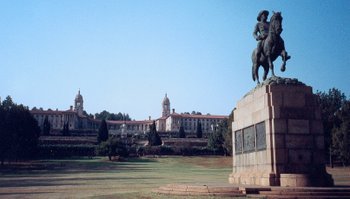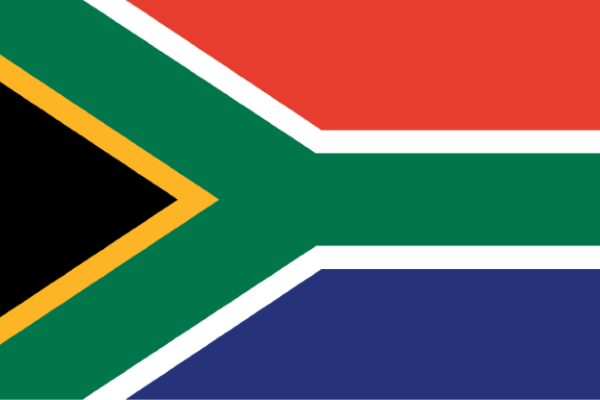THE UNION BUILDINGS
The Union Buildings form the official seat of the South African government and also house the offices of the President of South Africa. The imposing buildings sit on Meintjies Kop and overlooks Pretoria.

ARCHITECTURE
These buildings, built from light sandstone, were designed by the architect Sir Herbert Baker in the English monumental style and are 275 m long. They have a semi-circular shape, with the two wings at the sides, this serve to represent the union of a formerly divided people (see the talk page). The east and west wings of the building represent two languages, English and Afrikaans. These buildings are considered by many to be the architect's greatest achievement and a South African architectural masterpiece.
HISTORY
Andries Francois du Toit (1813-1883) was the original owner of the land on which the Union Buildings were built. He was also Pretoria’s first magistrate and was responsible for the layout of the city. During this period he sold his land, called Arcadia, to Stephanus Jacobus Meintjies (1819-1887), after whom the hill is named.
The cornerstone was laid in November 1910, shortly after the Union of South Africa — for which the buildings are named — was formed. Taking 1,265 workers over three years to build, the structure was completed in 1913 at a total cost of £1,310,640 for the building and £350,000 for the site.
GARDENS AND GROUNDS
Notable are the terraced gardens, planted exclusively with indigenous plants, surrounding the buildings as well as the 9,000 seat amphitheatre.
Within the grounds of the Union Buildings are various monuments and statues. A large statue of General Louis Botha (First prime minister of the Union of South Africa) on horseback dominates the lawn. The Delville Wood War Memorial is a tribute to South African troops who died during the First World War and sits at the top of the gardens, where there is a statue of prime minister J.B.M. Hertzog.
HISTORICAL EVENTS
On August 9, 1956 20 000 women staged a march on the Union Buildings to protest against the proposed amendments to the Urban Areas Act (commonly known as the pass laws) of 1950. They left bundles of petitions containing more than 100 000 of signatures at prime minister J.G. Strijdom's office door.
Outside they stood silently for 30 minutes, many with their children on their backs. Those who were working for white people as nannies were carrying their (white) charges with them. The women sang a protest song that was composed in honour of the occasion: Wathint’Abafazi Wathint’imbokodo! (Now you have touched the women, you have struck a rock.). In the last 50 years since, the phrase (or its latest incarnation: "you strike a woman, you strike a rock") has come to represent women's courage and strength in South Africa.
The march was lead by Lilian Ngoyi, Helen Joseph, Rahima Moosa and Sophia Williams-De Bruyn.
Since 1994 August 9 is commemorated annually and is known as Women’s Day in South Africa. In 2006 a re-enactment of the march was staged for its 50th aniversary, with many of the 1956 march veterans attending.
On May 10, 1994 the Inauguration of Nelson Mandela and his Vice-Presidents after the country's first free elections took place at the Union Buildings. This date is considered as the "birth" of the new South Africa.
HOW TO FIND US:
Found Cnr Church str and Zeederberg opposite the Sheraton Hotel in Arcadia, the Union Buildings is one of South Africa's foremost monuments. A popular place for picnics and tourists, always be careful and preferably visit the union buildings during the day.
The Union Buildings are an out door museum and no entrance fees, No tel no's applicable
Access: you can reach the Union Buildings quite easily by bus, taxi, as they are on the main road into Pretoria Central. There is parking at the top of Union Buildings.
As always in travelling, it is advisable to not leave valuables in the car, or to go at night or alone at night. There are generally a few people around during the day.

Kingdom Worker
Non-academic three year course in Theology for ministry leaders, deacons, elders and pastors in Africa












